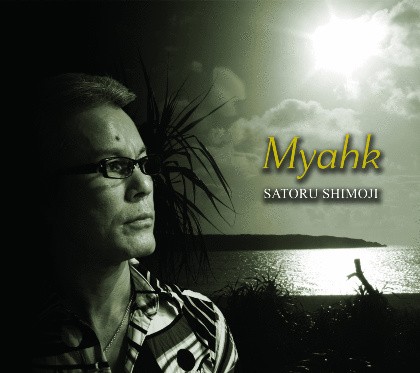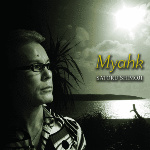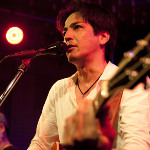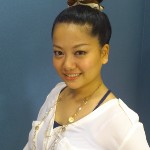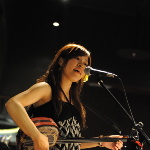MIYAKO ARTISTS SING THE ISLAND BLUES
Even within modern Japan, it may be surprising to know that pockets of the musically unexplored still remain, even for Japan’s most revered globetrotting producer, Makoto Kubota (of Blue Asia and many other projects).
“I never thought there is such a deep rich folklore in my own country. It was a big surprise’ he recalls after visiting the tiny island of Miyako for the first time in 2007. “I thought, wow, this place has a different vibe and culture, and eventually I noticed they speak a different language. Like Portugal to Spain, Miyako is to Okinawa and naturally the music is different too.”
The Miyako islands are a group of eight islands that form part of the Ryukyu chain, poetically described as a ‘knotted rope cast into a distant sea’. These seventy three sub-tropical islands that make up modern day Okinawa prefecture stretch for over 700km from Kagoshima (mainland Japan’s southernmost prefecture) almost to Taiwan. Miyako is situated about 300km southwest of the main Okinawan island.
The music of the Ryukyus’ has an indefinable island quality. A bit like everywhere, but totally unlike anywhere, Okinawan music has developed from a unique set of influences down the centuries, as local traditions have mingled with those of seafaring and trading nations. Decidedly different to the Okinawan mainland, traditional Miyako songs are characterized by beautiful melodies and sad themes, a legacy of a sometimes tragic history of harsh taxation and natural disasters.
“It’s serious folkloric” enthuses Kubota, “being sung by real fishermen and farmers, not professionals. There’s no musical education, no authority, no committee, no school, not even music score. They inherited the music by ear and by mouth. Miyako was left alone for a long long time, for ten centuries or more, and the people, music and culture developed in its own way” explains Kubota. “They don’t sing for tourists, they sing for themselves, to encourage themselves, because they had a harsh, heavy taxation for hundreds of years. They have a lot of reasons to sing the blues, just like black people did in the new continent.”
This tradition however, has been in real danger of dying out, even in recent years. One local musician decided to do something about it. Satoru Shimoji, born in 1957, had been making a living as a rock musician in Tokyo for 15 years, yet a sense of a ‘cultural crisis’ at home compelled him to return to Miyako in 1992. His idea was to perpetuate the unique language of Miyako through the medium of music. Combining Miyako island music and language with modern sensibilities and sounds, Satoru recorded a succession of albums for both independent and major labels that appealed to young people within Miyako and the Japanese mainland. A veritable one man ‘tour de force’ in promoting Miyako island music, he has gone on to record or produce over 70 records, including by many local artists, launch Miayko’s first music and satellite broadcast studio, record label and festival dedicated to Miyako’s arts and traditions.
In 2009 Satoru was one of the artists featured on Blue Asia’s groundbreaking album Sketches of Myahk produced by Makoto Kubota. A track featuring Satoru, Kun-nu-Shu, was selected by the late and greatly missed British broadcaster Charlie Gillett on his final Sound of the World compilation, Anywhere on This Road, released in 2010.
In 2012, to celebrate Satoru’s twenty year involvement in Miyako island music, he released the acclaimed album Myahk, that celebrated the present with some beautiful melodies, yet took stock of the past with tracks that evoke the spirit of a bygone era, and others that foreshadowed the future, with a new direction and sound.
Satoru has received many awards and plaudits for his work, including the ‘11th Hometown Event Award’ from the Japanese government, ‘Vitalization Of Island Encouragement Prize’ from the Okinawa prefecture government and the ‘Okinawa Cultural Association Award’ from the Okinawa Cultural Association. In addition he was appointed as the ‘Ambassador of Miyako Island’ a position he continues to hold today, for his efforts to keep alive the local language and culture.
Born in 1969, Isamu Shimoji (no relation to Satoru) a singer/songwriter, predominantly playing acoustic guitar, is a very different type of musician to his namesake but whose sensitive songwriting skills and lyrics in the Miyakofutsu dialect have caught the imagination of a wider Japanese audience and increasingly overseas too. A relative latecomer to songwriting, he wrote his first song aged 30. Dedicated to his father, the song became a word of mouth hit. His career has been on a gradual rise ever since, with an album released just about every year, culminating with a large outdoor concert in Miyako in 2012 to celebrate his ten year anniversary since that first record with thousands of fans coming from all over Japan. His music, despite being mostly just his vocals and acoustic guitar backed up by bass, drums and keyboards retains a strong spirit and vibe of Miyako, both in his distinctive lyrics and his soulful performance.
Isamu is also half of the duo Sakishima Meeting, with sanshin (3 stringed banjo) player and vocalist Yukito Ara from nearby Ishigaki island who together penned the song Tome Dome especially written as the theme song for the Canadian movie filmed in Okinawa, Karakara.
Two young female singers from Miyako encapsulate the current vitality of the local music scene. Born in 1984, Haruna Shinzato grew up listening to and playing the local folk music on the sanshin. A regular presenter on local television, she often featured the island’s musicians, which inspired her to become a professional musician herself. She has since immersed herself in the island traditions as well as writing her own Miyako inspired songs.
Minami Shimoji, as the daughter of Satoru Shimoji, grew up surrounded by local island music. With her group ‘Pani Pani Girls’ she released her first record aged 12, produced by her father. Ever mindful to carve out her own career and direction, she learnt piano and sanshin while at school. She later developed a great interest in the percussion instrument that accompanies much Miyako and Okinawan music, sanba- three pieces of wood held in one had, and stroked with the fingers of the other, castanet style. She now plays sanba in her father’s band, as well as performing regularly at events on Miyako and on local television.
In 2013, thanks to the efforts of Satoru Shimoji and others, the profile of Miyako folk and traditional music has never been so high. A film of Sketches of Myahk was released, and formed part of the official selection of the world famous Locarno Film Festival in 2011. This film has just been released onto DVD. It seems the story of Miyako island roots music and more importantly, the personality of its musicians convey universal themes that can strike a chord with anyone. As Kubota says “They (Miyako islanders) have something we (Japanese) have lost. In Miyako the people are very straightforward. You feel they are proud and have nothing to hide. When you hear it, this music, goes straight to your soul.”
Paul Fisher
October 1st 2013
article posted by:Ms Akiko Yanagisawa, Music from Miyakojima - Okinawa


